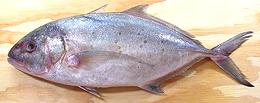
[family Carangidae, Genus Caranx, various species | Genus Seriola (amberjacks) | others]
Common names within family Carangidae are very disorderly, including Jacks, Amberjacks, Pompanos, Trevally and Scads, without clear differentiation as to which are which. This page deals with those most commonly called Jacks and Trevally, which tend to be some of the larger of the Carangidae, without too much regard to what genus they belong to. With 30 genera, the naming mess is impossible to make orderly. For other fish in this family see Pomponos, Scad and Bumpers.
More on Varieties of Fish (very
large page)
 [Bluestripe Jack, Hardtail Jack; Caranx crysos]
[Bluestripe Jack, Hardtail Jack; Caranx crysos]
Belonging to the same family as Pompanos, Blue Runners are found
close to coasts and reefs on both sides of the Atlantic and in the
Mediterranean. They range from the southern tip of England to Angola,
and from Nova Scotia, Canada, to northern Brazil, including
the Gulf of Mexico and the Caribbean. They can grow to nearly 28 inches
and 11 pounds, but the photo specimen was fairly typical at 14 inches
and weighing 1 pound 1-1/2 oz. This fish is a minor commercial catch,
and is IUCN rated LC (Least Concern).
Details and Cooking.
 [Jackfish; Caranx caninus (Pacific) |
Caranx hippos (Atlantic)]
[Jackfish; Caranx caninus (Pacific) |
Caranx hippos (Atlantic)]
The Pacific and Atlantic fish may actually be the same species. The
Pacific, is found from Southern California to Peru and may grow to
almost 40 inches and almost 40 pounds, but the photo specimen was 11
inches and 11 ounces. Atlantic fish are found from Nova Scotia to
Uruguay and have grown to over 48 inches and 70 pounds.
Details and Cooking.
 [Carangoides fulvoguttatus]
[Carangoides fulvoguttatus]
Belonging to the same family as Jacks and Pompanos, Yellowspotted
Trevally are found in the Indo-West Pacific tropical and subtropical
regions.They can grow to 47 inches and nearly 40 pounds, but the
photo specimen was 16-3/4 inches and weighed 2 pounds 8-1/2 oz.
This fish is Red List rated as NE (Not Evaluated) and is not considered
threatened. Like other fish in this family, this is a very fine eating
fish.
Details and Cooking.

This fish is actually a Scad,
but often called "Trevally" in Philippine fish markets (they are
related).
 [California Yellowtail; Seriola lalandi]
[California Yellowtail; Seriola lalandi]
This large jack is found along coasts worldwide, from north subarctic
to south subarctic. This is a prize game fish off the coast of
California and can grow to over 8 feet long and over 200 pounds, but
the photo specimen was 27 inches and 7.44 pounds.
Details and Cooking.

[Seriola quinqueradiata]
This large jack is is found mainly along the coasts of Japan and
Korea, but can sometimes be found as far east as Hawaii and Baja
California. This fish can grow to about 5 feet and 80 pounds, but
the photo specimen was 19 inches long and weighed 3 pounds 2 ounces.
It is very popular in Japan eaten both raw and cooked.
Details and Cooking.

[Allied Kingfish, Great Amberfish, Greater Yellowtail, Jenny Lind, Sea Donkey, Reef Donkey; Kanpachi (Japan); Seriola dumerili of family Carangidae]
Native to the the tropics and subtropics almost worldwide, this fish can
grow to 6 feet and 178 pounds, but is commonly about 3-1/4 feet. It is
considered an excellent eating fish, especially for sushi and sashimi in
Japan. IUCN Red List LC (Least Concern).
Details and Cooking.
 [Slender Leatherskin; Lapis, Forado, Talang-talang
(Philippine); Scomberoides tol | similar: Doublespot
Queenfish; Lapis (Philippine); Scomberoides lysan]
[Slender Leatherskin; Lapis, Forado, Talang-talang
(Philippine); Scomberoides tol | similar: Doublespot
Queenfish; Lapis (Philippine); Scomberoides lysan]
Native to the tropics and subtropics of the Indo Pacific, from
the east coast of Africa to the west coasts of North and South America,
This fish can grow to 2 feet long and a little over 1 pound, but the
photo specimen was 13-1/2 inches long and weighed 8-3/8 ounces. The
Doublespot Queenfish is almost identical except it has another row
of smaller spots below the main spots, and it grows a little bigger.
Details and Cooking.

These two very similar fish are found around New Zealand and southern
Australia. The far more numerous Yellowtail is often confused with
the related Yellowtail Scad. It is more slender, the fins are slightly
different, and the row of scutes turns more steeply upward. For prep
and cooking, our
Yellowtail Scad page should
work fine.
Photo by Clinton Duffy, non-commercial, attribution
required.
 [Maasbanker (Afrikaans); Trachurus capensis]
[Maasbanker (Afrikaans); Trachurus capensis]
The Cape Horse Mackerel is native to the west coast of Africa from
the Gulf of Guinea south to the tip of Africa, and most numerous off
Namibia and South Africa. While it is mainly bycatch from other
fisheries, this fish is so abundant it is a major
commercial catch in the region. This fish can grow to 25 inches
but is more commonly 12 inches long. IUCN Red List status NE (Not
Evaluated).
Photo by Frederick Hermanus Van der Bank, University of
Johannesburg contributed to the Public Domain.